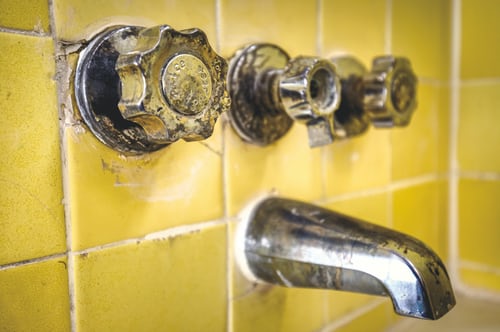What are your ideas about How to Repair and Prevent Bathroom Water Damage??

Water damage commonly occurs in the restroom due to the water used everyday. Often, the damage could be a little mold from the shower. Various other times, it's substantial damages on your flooring. Whatever it is, it is always good to recognize the cause and stop it prior to it occurs.
This guide will certainly undergo a few of the common causes of water damage in the washroom. We will additionally analyze what you can do to prevent these reasons from harming your shower room. Allow's dive in.
These are the common factors you would certainly have water damage in your restrooms and just how you can find them:
Excess Moisture
It's cool to have that lengthy shower as well as splash water while you hem and haw as well as imitate you're carrying out, yet often these acts could create water damage to your shower room.
Splashing water around can create water to visit edges and also develop molds. Enjoy how you spread out excess wetness around, and also when you do it, clean it up to avoid damage.
Fractures in your wall floor tiles
Washroom wall floor tiles have been particularly created for that purpose. They secure the wall from dampness from people taking showers. Nonetheless, they are not unbreakable.
Occasionally, your restroom wall surface tiles fracture and enable some dampness to permeate into the wall. This can potentially ruin the wall surface if you don't take any type of activity. If you notice a fracture on your wall floor tiles, repair it immediately. Don't wait up until it destroys your wall.
Overflowing bathrooms as well as sinks
As human beings, sometimes we make mistakes that can create some water damage in the bathroom. For example, leaving your sink tap on could cause overruning and also damages to various other parts of the washroom with dampness.
Additionally, a faulty toilet can trigger overruning. For example, a damaged commode take care of or other parts of the cistern. When this takes place, it could harm the flooring.
As soon as you discover an overflowing sink or bathroom, call a plumbing professional to help handle it quickly.
Burst or Leaking Pipelines
There are lots of pipes carrying water to various parts of your shower room. Some pipelines take water to the bathroom, the sink, the faucets, the shower, and also several various other areas. They crisscross the tiny location of the bathroom.
From time to time, these pipelines can obtain corroded as well as ruptured. Other times, human action might cause them to leak. When this happens, you'll discover water in the corners of your restroom or on the wall.
To find this, look out for bubbling wall surfaces, mold and mildews, or mold. Call a specialist emergency situation plumber to repair this when it takes place.
Roof covering Leakages
Often, the issue of water damage to the restroom may not come from the bathroom. For example, a roof covering leakage might trigger damage to the washroom ceiling. You can detect the damages done by considering the water spots on the ceiling.
If you discover water stains on your ceiling, examine the roofing to see if it's damaged. Then, call a specialist to assist resolve the concern.
Final thought
Water damage to your shower room can be bothersome. However, you can manage it if you protect against some of the causes stated in this overview. Call a professional emergency plumbing professional if you discover any severe damages.
How to Prevent Water Damage in Your Bathroom?
Water damage repair is an expensive, meticulous, and lengthy process. Unfortunately, bathrooms are the most susceptible rooms to water damage due to toilets, showers, and sinks. Pipes and fixtures wear out over time and are not immune to damage. But all is not lost, as there are ways to prevent water damage from occurring in your bathroom.
Check Your Plumbing
Nothing lasts forever, especially pipes, which can rust and begin leaking over time. You should periodically conduct pipe inspections and pay attention for any musty smells or water stains that may indicate you need water damage repair. Here are some things to check:
Frequently test valves for your toilet, shower, and sink to ensure they are properly working. Check faucet supply lines hidden under vanities and replace when needed. Replace cracked or deteriorating caulking along sinks, tubs, and showers. If you notice a clog in your sink, call in a professional. Since you can’t check the pipes in the wall, keep an eye out for stains, drywall bubbling, musty smells, and excess moisture; if the bathroom is on a second level, check the ceiling of the room directly below for these signs. Don’t Overwork Your Toilet
One of the most common reasons bathrooms need water damage repair is due to overflowing toilets. Save yourself the hassle of cleanup by being mindful and not pushing your toilet to extreme limits. If you have young children, it is especially important to keep an eye on them when they are in the bathroom and to teach them how to avoid clogging the toilet. Here are some more tips to help prevent your toilet from overflowing:
If you have a septic tank, only use septic-safe toilet paper Do not flush anything down the toilet besides toilet paper; items like diapers and sanitary napkins will clog the piping Pay attention to your toilet’s water level: If it’s low, it could mean it is partially clogged or that there is a crack in the toilet bowl https://www.alure.com/home-improvements-blog/resources/how-to-prevent-water-damage-in-your-bathroom

As a reader on How to Repair and Prevent Bathroom Water Damage?, I think sharing that article post was really useful. Sharing is good. You just don't know, you could be helping someone out. Thanks for your time spent reading it.
Prioritize your plumbing; call us.